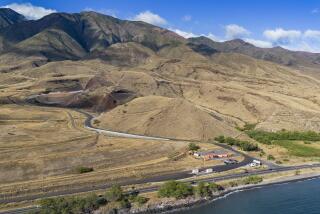State to Allow Radioactive Debris at Regular Landfills
A little more than two years after the state abandoned plans to open a nuclear waste dump at Ward Valley in the Mojave Desert, officials are set to allow shipment of radioactive debris to ordinary landfills never designed to safely store such material.
Under a policy finalized in November by the state Department of Health Services, dirt and debris from decommissioned nuclear power plants and other mothballed facilities could be disposed of without the oversight, licensing and monitoring that have long been required of all radioactive waste.
Although Ward Valley would have been closely monitored, the site, about 20 miles from the Colorado River, raised fears that radioactive particles could migrate to the river or into other drinking water sources.
Now, critics of the latest policy fear that similar radioactive waste will instead wind up in poorly designed landfills, where it could emit radiation at levels more than 10 times higher than would have been permitted at the Mojave Desert site.
“There are 170 municipal waste facilities in the state and no one knows if they’ll become nuclear waste sites, and it’s all happened overnight and under cover of dark,” said Dan Hirsch, president of the Committee to Bridge the Gap, which opposed the Ward Valley site and is suing the state over the new disposal policy.
The state’s top radiologic health official countered that a provision of federal law has always allowed disposal in landfills of radioactive debris and soil from decommissioned nuclear sites.
The official said his agency has adopted recently toughened federal standards for how much radiation can remain at dismantled nuclear facilities before they are freed from regulation and material from them is eligible for disposal elsewhere.
“It could have been released a few years ago at much higher [radiation] levels,” said Edgar Bailey, chief of the Radiologic Health Branch of the state Department of Health Services.
Nonetheless, just more than two years ago, Bailey informed Safety-Kleen Inc., an industrial waste site operator in Kern County, that accepting any material with the most minimal amounts of radiation “would be a violation of California law.” Safety-Kleen had been accepting material from a former Manhattan Project site in New York.
The new state policy, however, applies only to material from sites that have been “released for unrestricted use,” which had not happened at the New York site that sent its material to Safety-Kleen.
In California, at least half a dozen power plants and laboratory sites are poised for decommissioning. If the sites are given a clean bill of health by regulators, they can be used for a variety of purposes, even for new housing or parks.
The U.S. Nuclear Regulatory Commission allows unrestricted use of a decommissioned facility if what remains at the site won’t expose a hypothetical resident to more than 25 millirems of radiation annually--roughly equal to about 2 1/2 chest X-rays.
“Nothing on the site can exceed that amount,” Bailey said.
“To get that dose, you have to be living on the site, you have to grow your crops there, and you have to drink from the wells there.”
But the 25-millirem exposure level is not a measure of the radioactivity of specific waste matter or chunks of soil. It is a measure of the intensity of radiation that would percolate out on hypothetical pathways, and is based on factors that include soil densities and the type of development expected in the area.
Activists and landfill regulators worry that truckloads of dirt or individual items of debris could be both “hotter” than would have been allowed at Ward Valley and much more exposed to the public at municipal landfills, which are not equipped or licensed to isolate radioactive waste.
Bailey acknowledged that there is “a remote possibility” that some debris from a decommissioned site could be more radioactive than the overall average for the site.
“It’s astounding that [the Department of Health Services], not even having a clue on how municipal landfills are set up, makes a rule that affects all the landfills in the state,” said David Roberti, a member of the California Integrated Waste Management Board, which oversees the operation of municipal landfills statewide.
The Ward Valley facility, near Needles, was to have radiated no more than 2 millirems per year--less than one-tenth of the 25-millirem level the Department of Health Services now would allow a decommissioned site to radiate.
A closer look at the federal regulations adopted by the state, however, shows that exceptions can be granted that would allow decommissioned sites to radiate at levels many times higher than 25 millirems.
Antinuclear activists warn that such a scenario is likely. This week, they said, the Department of Energy decided it would clean up the former Rocketdyne site in Simi Valley only to its department standards and not to the stricter levels required by the U.S. Environmental Protection Agency. That difference in standards can translate to a steep increase in the statistical odds of cancer in populations exposed to hazardous chemicals.
Bailey said material from the former Rocketdyne facility could be sent to landfills, but only after it has been cleaned up to a promised level of 15 millirems.
“All of the waste that is leaving that is above 15 millirems is presently going to a low-level waste site, and it probably would go out of state anyway because it’s a Department of Energy project,” Bailey said.
More to Read
Sign up for Essential California
The most important California stories and recommendations in your inbox every morning.
You may occasionally receive promotional content from the Los Angeles Times.











